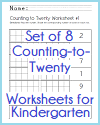| Grade 1 Math: Number and Operations in Base Ten |
|---|
| www.studenthandouts.com > First Grade > First Grade Math > Number and Operations in Base Ten |
| CCSS.MATH.CONTENT.1.NBT.A.1 - Count to 120, starting at any number less than 120. In this range, read and write numerals and represent a number of objects with a written numeral. |
|---|
| CCSS.MATH.CONTENT.1.NBT.B.2 - Understand that the two digits of a two-digit number represent amounts of tens and ones. Understand the following as special cases: |
|---|
| CCSS.MATH.CONTENT.1.NBT.B.2.A - 10 can be thought of as a bundle of ten ones — called a "ten." |
|---|
| CCSS.MATH.CONTENT.1.NBT.B.2.B - The numbers from 11 to 19 are composed of a ten and one, two, three, four, five, six, seven, eight, or nine ones. |
|---|
 |
||||||||||
| Shade Boxes to 20; Set of 8 Worksheets |
| CCSS.MATH.CONTENT.1.NBT.B.2.C - The numbers 10, 20, 30, 40, 50, 60, 70, 80, 90 refer to one, two, three, four, five, six, seven, eight, or nine tens (and 0 ones). |
|---|
| CCSS.MATH.CONTENT.1.NBT.B.3 - compare two two-digit numbers based on meanings of the tens and ones digits, recording the results of comparisons with the symbols >, =, and <. |
|---|
| CCSS.MATH.CONTENT.1.NBT.C.4 - Add within 100, including adding a two-digit number and a one-digit number, and adding a two-digit number and a multiple of 10, using concrete models or drawings and strategies based on place value, properties of operations, and/or the relationship between addition and subtraction; relate the strategy to a written method and explain the reasoning used. Understand that in adding two-digit numbers, one adds tens and tens, ones and ones; and sometimes it is necessary to compose a ten. |
|---|
| CCSS.MATH.CONTENT.1.NBT.C.5 - Given a two-digit number, mentally find 10 more or 10 less than the number, without having to count; explain the reasoning used. |
|---|
| CCSS.MATH.CONTENT.1.NBT.C.6 - Subtract multiples of 10 in the range 10-90 from multiples of 10 in the range 10-90 (positive or zero differences), using concrete models or drawings and strategies based on place value, properties of operations, and/or the relationship between addition and subtraction; relate the strategy to a written method and explain the reasoning used. |
|---|
| First grade math on number and operations in base ten focuses on understanding the number system and place value. Students learn to count, read, and write numbers up to 120, recognizing the value of each digit in two-digit numbers. They practice grouping objects into tens and ones, which helps them grasp the concept of place value. Additionally, first graders work on comparing numbers using greater than, less than, and equal to, and they begin simple addition and subtraction within 100. Mastering these skills is crucial for their future understanding of more complex mathematical concepts and operations. |
| www.studenthandouts.com > First Grade > First Grade Math > Number and Operations in Base Ten |






